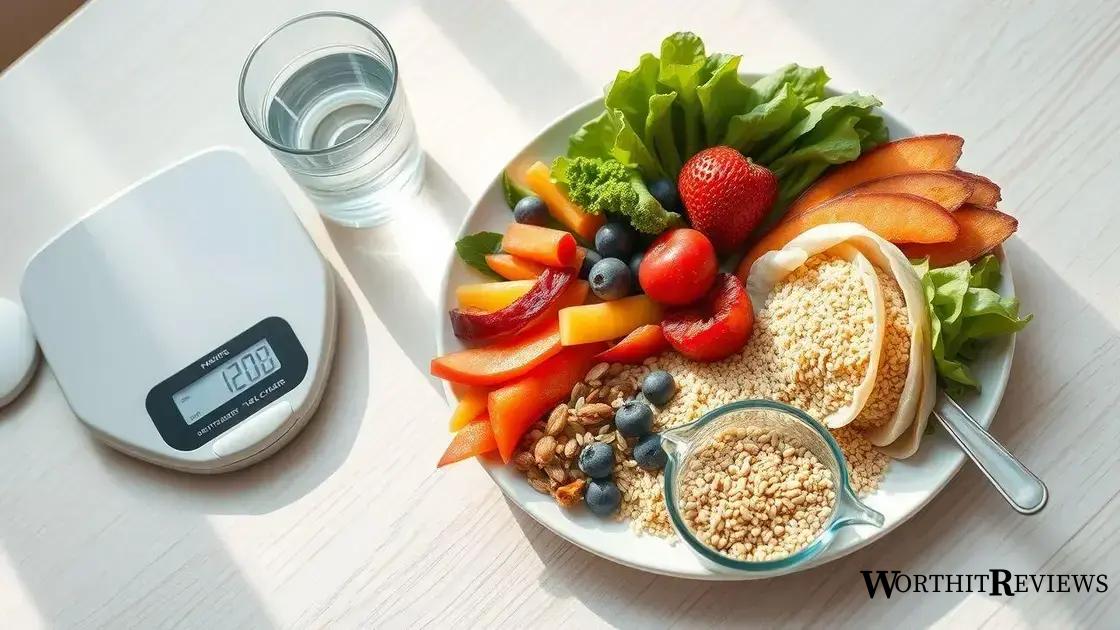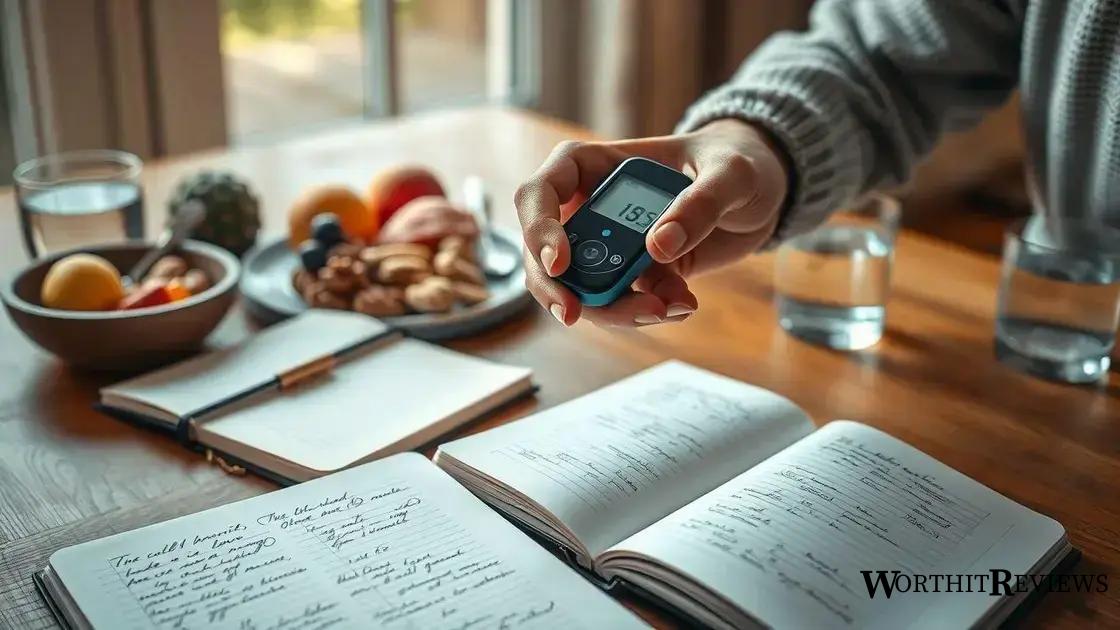Managing blood sugar levels with type 2 diabetes involves regular monitoring, maintaining a balanced diet, engaging in physical activity, and consulting healthcare professionals to ensure effective treatment and overall health management.
When we talk about blood sugar levels with type 2 diabetes, it’s crucial to understand how they impact daily life. Have you ever wondered how your diet and activity influence these levels? Let’s dive into the essentials.
Understanding blood sugar levels
Understanding blood sugar levels is essential, especially for those with type 2 diabetes. Blood sugar, or glucose, is the main sugar found in your blood. The body gets it from the food you eat, and it serves as a vital source of energy.
What Are Normal Blood Sugar Levels?
Normal blood sugar levels can vary, but typically, they range from 70 to 130 mg/dL before meals and less than 180 mg/dL two hours after eating. Monitoring these levels helps in managing diabetes effectively.
How Blood Sugar Levels Fluctuate
Blood sugar levels can fluctuate based on various factors, including the type of food consumed, physical activity, and stress. For example, eating a meal high in carbohydrates can cause a spike in blood sugar levels, while exercise tends to lower them.
Impact of Type 2 Diabetes on Blood Sugar
In type 2 diabetes, the body does not use insulin effectively, which can lead to elevated blood sugar levels. This condition requires diligent monitoring and lifestyle adjustments to maintain healthy levels.
Importance of Monitoring
Regular monitoring of blood sugar levels is crucial for individuals with type 2 diabetes. Understanding how your blood sugar responds to different foods and activities can help manage your condition and prevent complications.
How to Check Blood Sugar Levels
There are several methods to check blood sugar levels, including fingerstick tests and continuous glucose monitors (CGMs). It’s important to work with your healthcare provider to choose the best monitoring method for you.
How type 2 diabetes affects your health

Type 2 diabetes can significantly affect your health in many ways. One major concern is the risk of heart disease. People with diabetes are twice as likely to develop heart conditions, such as heart attacks and strokes.
Impact on Blood Vessels
High blood sugar levels can damage blood vessels over time. This damage can restrict blood flow and lead to complications in various organs, including the heart and kidneys.
Effects on Vision
Diabetes can also lead to serious eye conditions. Diabetic retinopathy, cataracts, and glaucoma are common among individuals with uncontrolled blood sugar levels. Regular eye exams are crucial.
Nerve Damage
Another serious effect is nerve damage, known as diabetic neuropathy. This condition can cause pain, tingling, or numbness, particularly in the feet and hands. Managing blood sugar levels can help prevent this issue.
Kidney Health
Kidneys filter waste from the blood, but diabetes can harm them. Diabetic nephropathy can occur, leading to kidney disease and, in severe cases, kidney failure.
Skin Conditions
People with type 2 diabetes may experience various skin conditions, such as bacterial infections, fungal infections, and itching. Keeping blood sugar levels stable can improve skin health.
Signs of high and low blood sugar
Recognizing the signs of high and low blood sugar is crucial for managing type 2 diabetes effectively. Being aware of these signs can help prevent complications.
Signs of High Blood Sugar (Hyperglycemia)
High blood sugar can lead to various symptoms. Common signs include:
- Frequent urination: High glucose levels cause the kidneys to work harder, leading to more urination.
- Increased thirst: As you lose fluids, you’ll feel thirstier.
- Fatigue: When your cells can’t use glucose for energy, fatigue sets in.
- Blurred vision: High blood sugar can affect the lens of your eyes, making it hard to see.
- Slow healing: Cuts and wounds take longer to heal due to poor circulation.
Signs of Low Blood Sugar (Hypoglycemia)
Low blood sugar is equally important to detect. Symptoms may include:
- Shakiness: You may feel jittery or shaky as your body reacts to low sugar levels.
- Sweating: Excessive sweating can occur even in cool environments.
- Dizziness: Low blood sugar can cause dizziness and weakness.
- Confusion: You might find it hard to concentrate or think clearly.
- Hunger: A sudden feeling of hunger can strike when blood sugar dips too low.
Understanding these signs can help individuals with type 2 diabetes take action early. Always consult with a healthcare provider for monitoring and management strategies.
Effective dietary strategies

Managing type 2 diabetes effectively involves implementing effective dietary strategies. A balanced diet can help regulate blood sugar levels and improve overall health.
Focus on Whole Foods
Incorporating whole foods like fruits, vegetables, whole grains, and lean proteins is essential. These foods are nutrient-dense and help stabilize blood sugar levels.
Control Carbohydrate Intake
Monitoring carbohydrate intake is crucial. Choose complex carbohydrates, such as brown rice and whole grain bread, over simple sugars. This can prevent spikes in blood sugar.
Portion Control
Practicing portion control can aid in weight management. Using smaller plates and measuring food can help keep portions in check, reducing excess calorie intake.
Healthy Fats
Incorporating healthy fats, like those found in avocados, nuts, and olive oil, can provide essential nutrients without compromising blood sugar levels.
Plan Regular Meals
Eating at regular intervals helps maintain stable energy levels and prevents extreme highs and lows in blood sugar. Aim for three balanced meals and healthy snacks each day.
Stay Hydrated
Drinking plenty of water is important. Staying hydrated supports all bodily functions and can help control hunger levels.
Limit Processed Foods
Avoiding processed and sugary foods is key. These foods can lead to uncontrolled blood sugar spikes and create long-term health issues.
The role of physical activity
The role of physical activity is vital in managing type 2 diabetes. Regular exercise can help control blood sugar levels and improve overall health.
Benefits of Exercise
Engaging in physical activity offers numerous benefits for people with diabetes. Exercise helps:
- Lower blood sugar levels: Physical activity aids your body in using insulin more efficiently, which can lead to improved blood sugar control.
- Manage weight: Regular exercise helps maintain a healthy weight, which is crucial for managing diabetes.
- Boost heart health: Aerobic activities strengthen the heart and improve cardiovascular health, decreasing the risk of heart disease.
Types of Physical Activity
Incorporating various types of exercise into your routine is beneficial. Consider:
- Aerobic exercise: Activities like walking, jogging, swimming, or cycling can enhance heart and lung health.
- Strength training: Lifting weights or using resistance bands can increase muscle mass, which improves insulin sensitivity.
- Flexibility and balance exercises: Yoga or tai chi can enhance flexibility and balance, reducing the risk of injuries.
Recommendations
Aim for at least 150 minutes of moderate aerobic activity each week. Spread this out over several days to make it manageable. Additionally, include strength training exercises at least two days a week.
Staying Active Daily
Find ways to increase your daily activity levels. Simple changes, such as taking stairs instead of the elevator or going for short walks during breaks, can make a significant difference.
Monitoring blood sugar at home

Monitoring blood sugar at home is a critical part of managing type 2 diabetes. Keeping track of your blood sugar levels helps you understand how your diet and activity affect your health.
Why Monitor Blood Sugar
Regular monitoring helps you see patterns in your blood sugar levels. This information can guide your food choices, activity levels, and medication dosages.
How to Measure Blood Sugar
To measure your blood sugar, you will need a glucometer. Follow these steps:
- Wash your hands with soap and water to ensure cleanliness.
- Insert a test strip into the glucometer.
- Prick the side of your fingertip with a lancet to get a drop of blood.
- Touch the drop of blood to the test strip and wait for the meter to display your blood sugar level.
When to Check Blood Sugar
Check your blood sugar at different times of the day to get a complete picture. Common times include:
- Before meals: To see how your levels respond to food.
- Two hours after meals: To check how effectively your body is managing blood sugar.
- Before and after exercise: To ensure your levels remain stable during physical activity.
Keeping a Log
Keeping a blood sugar log can help you track your levels over time. Include details like what you ate, your activity level, and any medications taken. This can help identify trends and adjustments needed in your management plan.
Consult Your Healthcare Provider
Your healthcare team can help you set goals for your blood sugar levels and offer tips for effective monitoring. Regular check-ins are important to adjust your management plan as needed.
When to consult a healthcare professional
Knowing when to consult a healthcare professional is essential for managing type 2 diabetes effectively. Your healthcare team can provide guidance on your treatment plan and help you address any concerns.
Signs to Schedule an Appointment
If you experience any of the following symptoms, it’s important to contact your healthcare provider:
- Uncontrolled blood sugar levels: If your blood sugar readings are consistently too high or too low, seek professional help.
- Changes in vision: Blurriness or sudden changes in vision can indicate problems that require evaluation.
- Increased fatigue: Feeling unusually tired might signal an issue with blood sugar management.
- Unexplained weight loss: Losing weight without trying can be a sign of uncontrolled diabetes.
- Slow-healing wounds: Delayed healing of cuts or sores may indicate poor blood circulation or other health problems.
Regular Check-Ups
You should have regular check-ups with your healthcare provider, even if you feel well. Aim for at least twice a year for monitoring your diabetes and discussing your management plan.
Medication Management
If you have concerns about your medications or need adjustments, consult your healthcare professional. They can determine if there are better options for you.
Nutrition and Exercise Advice
Seeking advice on nutrition and physical activity from a healthcare provider or dietitian can also be beneficial. They can help create personalized plans that fit your lifestyle and health goals.
Comprehensive Diabetes Care
Don’t hesitate to ask questions or express concerns during your visits. Effective communication is key to successful diabetes management.
In summary, managing type 2 diabetes effectively
Managing type 2 diabetes involves understanding blood sugar levels, maintaining a healthy diet, and staying active. Regular monitoring and consulting with healthcare professionals are key aspects of effective management.
By recognizing the signs of high and low blood sugar, you can take control of your health. Using effective dietary strategies and engaging in physical activity can greatly improve your overall well-being.
Don’t hesitate to seek guidance from healthcare providers. They can support you by providing personalized advice that fits your needs.
With the right approach, it is possible to lead a healthy and fulfilling life with diabetes. Take charge of your health today!
FAQ – Frequently Asked Questions About Managing Type 2 Diabetes
What are the signs of high blood sugar?
Common signs of high blood sugar include frequent urination, increased thirst, fatigue, and blurred vision.
How can I monitor my blood sugar at home?
You can monitor your blood sugar at home using a glucometer. Make sure to follow the instructions for accurate readings.
What dietary strategies should I follow for diabetes management?
Focus on whole foods, control carbohydrate intake, practice portion control, and avoid processed foods.
How often should I exercise to manage my diabetes?
Aim for at least 150 minutes of moderate aerobic activity each week, along with strength training at least two days a week.
When should I consult a healthcare professional?
Contact your healthcare provider if you experience symptoms like uncontrolled blood sugar levels, changes in vision, or persistent fatigue.
What role do healthcare professionals play in managing diabetes?
Healthcare professionals provide guidance on medication, diet, and exercise, ensuring that you have a personalized management plan.
